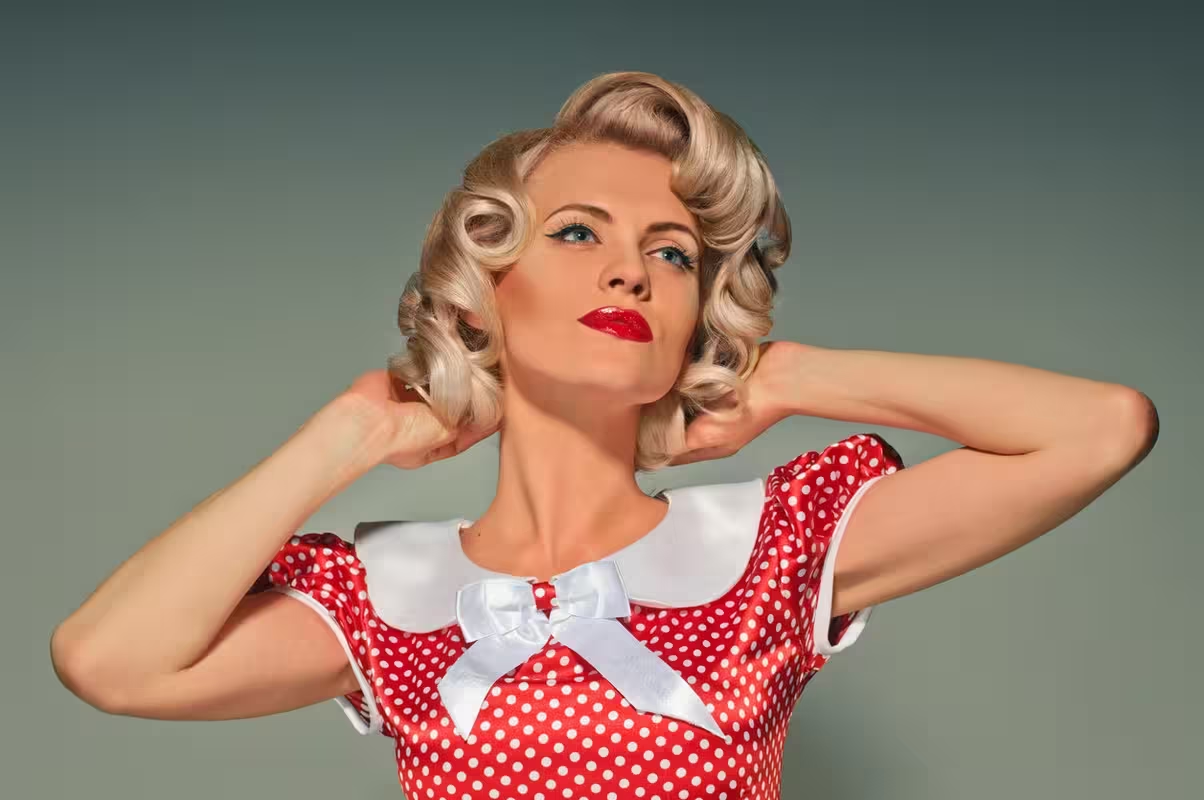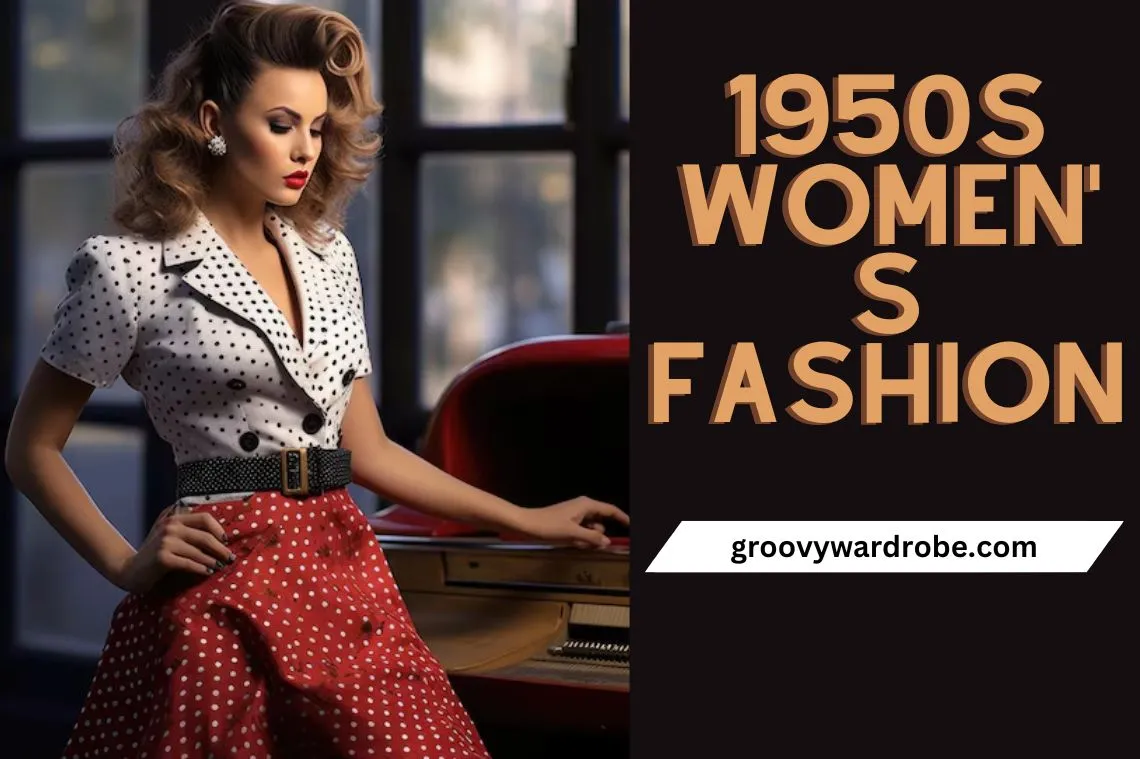A lesson in 1950s women's fashion history: Dior's New Look, Hollywood Bombshells, and The Golden Era of Couture. Not to argue over details, but the 1950s' appearance truly reflected a few years earlier. When scholars discuss 1950s fashion history, the period is typically described as 1947–1957—and coincidentally fits the years Christian Dior ran his design line. Following the death of the designer early in 1957, 21-year-old Yves Saint Laurent took over at the Dior, rounding off the decade with his beatnik-inspired collection of 1960.
Fashion peaked during this notorious period, reflecting the world's determination to left wartime ration and austerity policies behind. The fashion business produced, and then some; the world sorely needed beauty.
Celebrating the conclusion of World War II meant honoring women as women, capital W—with nipped waists, voluminous skirts, well done-up hair, and accessories for every conceivable occasion. Better or worse, the synchronization of hats, gloves, and handbags—the not-a-hair-out-of-place norm of the age—gave women countless stylish and cosmetic options. The decade may be regarded as a step back for women who pursued heavenly ether-levels of beauty, but boy, did it provide some amazing looks.
1950 Women's Fashion: The Hourglass Silhouette Returns

Dior's New View Highlights
The 1950s were dominated by the shape Christian Dior proposed in his 1947 New Look Corelle Line collection. The nipped-in-the-waist outfits, which accentuated the feminine form, reflected a fast-paced pendulum swing; in the 1940s, men's designs with clean wartime shoulders and slender hips dominated. Now hips were stretched with tulle and crinolines adding weight, waists were snatched and shortened to Victorian proportions, and shoulders were softened with padding that contoured them. Objectives: a profoundly "feminine" form.
"It begins at the waistline," Vogue's Paris Collection story from the March 1, 1952 edition concisely says. Right away, the waist attracts the attention. It's newly high, newly low, or both; however, it's always there, constantly accentuated, and therefore fashion seems more feminine than it has in years.
Read also: COACHELLA 2024 SET TIMES AND STREAMING SCHEDULE
Golden Age in Couture
Paris Recover After Its Occupation
"The Chambre Syndicale de la Couture has asked that any media displaying Paris models from this collection print the following line—to apply to all models shown: " Copyrighted model—reproduction restricted." Obviously, this does not apply to stores and manufacturers that have acquired the original designs. Printed in "Paris Collections Note" in Vogue's September 15, 1951 edition, this PSA was
Stated differently, the designs Paris couturiers were relentlessly putting out as their city recovered from their devastatingly deballassing German Occupation was fueling the world's ravenous thirst.
A clandestine industry of Parisian couture knock-offs grew and people with photographic memory were even sent by American department shops to the Parisian press for weeks to rapidly sketch what they saw to be swiftly replicated.
Scholars of fashion history now see the ten years 1947–1957—the ten years Monsieur Dior was designing—as Couture's Golden Age. Couturiers were fashioning the period, and it was ostentatious clothes at outrageous rates for luxurious lifestyle. By the conclusion of the decade, young fashion and the Space era look will replace the perfect beauty created during the golden era when designers used a high degree of miraculous fairness as though pushing the boundaries of beauty.
Read also: HOT ROLLERS VS CURLING IRONS: WHICH IS BETTER AND WHY
A stricter silhouette starts to show.

Chanel Slips Slides Back into Fashion
A fresh silhouette was developing half a decade into the New Look. Only for so long can fashion be current. The strict hourglass started to soften and lose its sharpness. Dior brought in Y-lines and H-lines. Starting with two stacked inverted triangles with touching points, the decade finished with the dominant profile of an upside-down triangle—a trapeze form or A-line silhouette that glided away from the body.
Not so quickly, but by 1958 hemlines were rising and skirts were flaring out, opening the path for the miniskirt's arrival. Designers were enjoying sophisticated, linear forms in the meanwhile that emphasized unbroken lines with an architectural flair rather than the waist.
Here Come the Stiletto Shoes.
Slender shoes becoming increasingly fashionable—and tall.
Who precisely "invented" the stiletto and, more importantly, what distinguishes a stiletto?Originally recorded as a description of a pointy, thin toe of a shoe, the term ( Italian for dagger) soon evolved to designate a tall slender heel. Three significant proponents of the style were definitely Roger Vivier, Salvatore Ferragamo, and André Perugia. Furthermore obvious is the early 1950s popularity of the heel. The elegant clothes of the decade found ideal punctuation in the thin, unassuming shoe.
Roger Vivier was then making shoes for Christian Dior. Dior said out of all his associates, Vivier was the only other artist who could obtain equal credit on a label, so the Vivier name appears next to Dior's inside each shoe.
Less well-known now is the footwear engineer André Perugia, who developed steel-based heels in the early 1950s and attracted media attention. Vogue honored the new rhinestone-encrusted, whisper-thin steel heel from Perugia in the November 15, 1951 edition.
" Above, the new suspension sandal. Rising on a tiny metal strip, the most amazing shoe concept ever developed for nighttime. (Sideways, there seems to be simply a tiny strip of rhinestones—no heel at all.) Still a Perugia dream, this concept for a small, thin—and unforgettable—sandal will be carried further in I Miller's American workrooms.
Read also: THINGS TO CONSIDER WHEN SHOPPING FOR MATERNITY BRIDESMAID DRESSES
Men's 1950s Trends:
If the postwar woman had her New Look from Dior, the post-war male was treated by tailors on Savile Row to the New Edwardian look—a slim-cut suit, sometimes three pieces, and occasionally with a velvet collar. Accessories consisted in bowler caps and silver-capped canes; jackets were single-breasted.
Apart from the young, wrong side-of- the-tracks appearances of Marlon Brandon and James Dean on film—think jeans, shirt, and sneakers—a whole new typology surfaced in the 1950s. Particularly in Great Britain, the "Teddy Boys" or "Teds"-look prevailed in teenage subculture. These Teddy Boys greased their hair back into quiffs, sporting tiny jackets and pants. Before Elvis arrived and blew it up stateside, artists in the UK connected with this visual.
Influential Fashion Designers of the 1950s
While Christian Dior gave birth to '50s fashion with his New Look in 1947, many other designers influenced the decade.
- Clare McCardell, an American designer, had introduced a casual country-girl look to clothing in the '40s using denim and gingham. She continued to design clothing throughout the '50s.
- Cristóbal Balenciaga gave us the 3/4 length sleeve. His designs offered a looser style that released women from stiffly structured tailored garments. Combining a loose coat with a pencil skirt created a unique new appearance. His 1957 sack dress without a waistline evolved into the shift-style dress that became so popular in the 1960s.
- Hubert de Givenchy was famous for creating clothing for his favorite muses Audrey Hepburn and Jackie Kennedy. He entered the Paris couture scene at an early age with designs based on separates with a youthful appeal.
- Coco Chanel reestablished herself as a designer after World War II with wearable clothing. Her boxy suits with contrasting trim, worn with a soft blouse adorned by a pussy-cat bow, were created for ease of movement. In 1955, she introduced her signature quilted handbag with a gilt chain strap; it is still popular.

